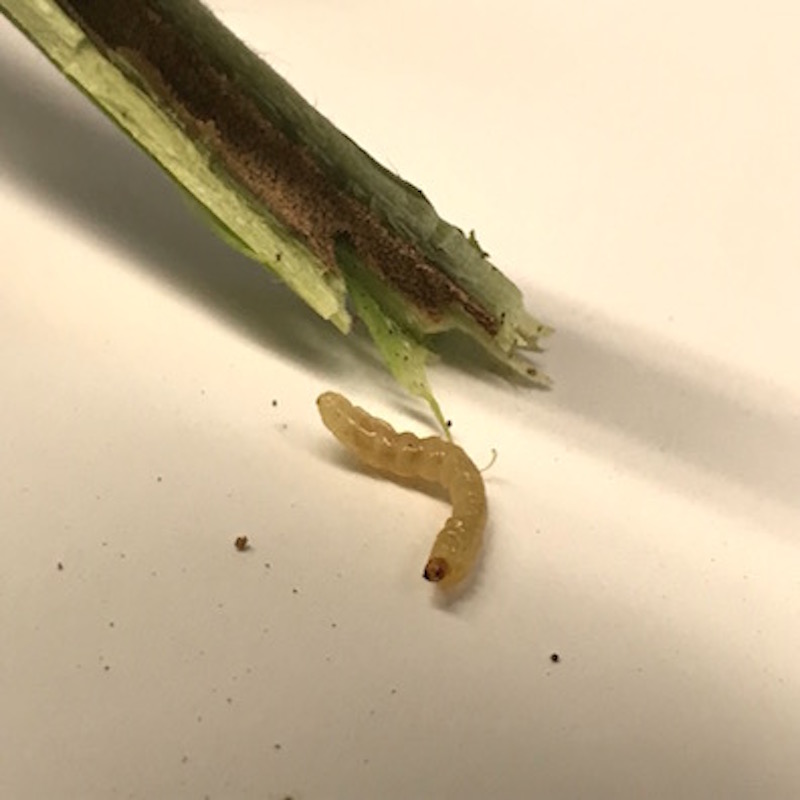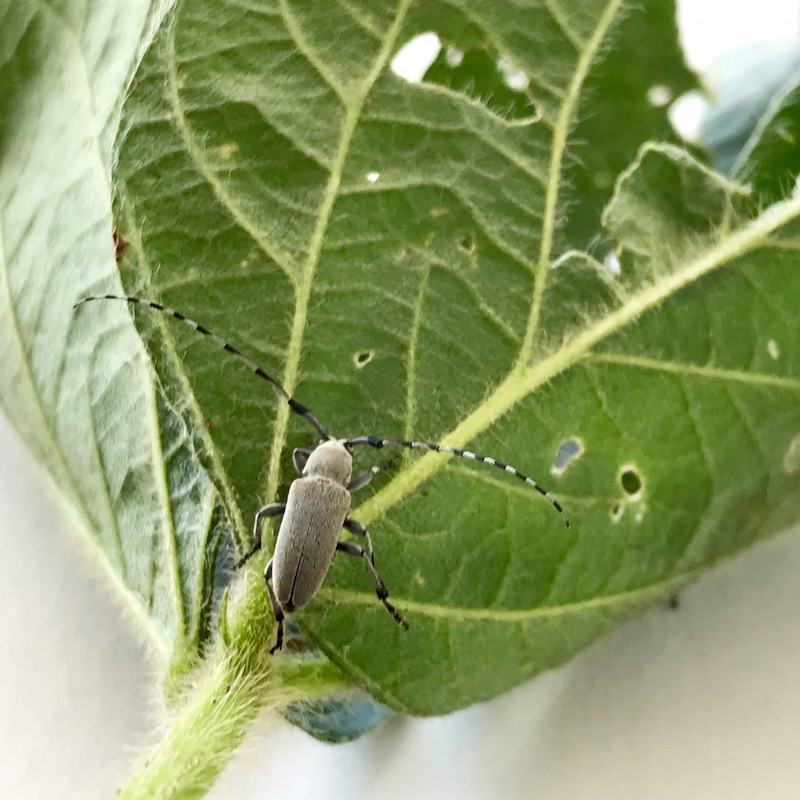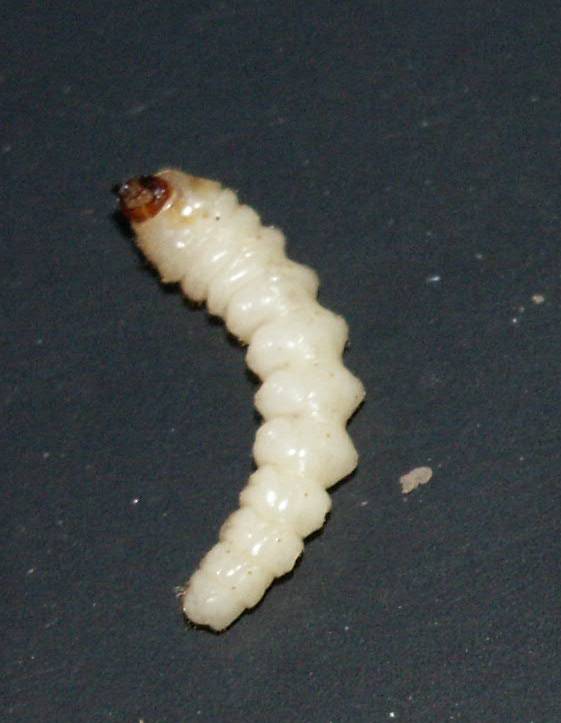

Identification
Adult beetles are gray to bluish-gray in color and range in size from 1.0 to 2.0 cm (3/8 to 3/4 inches) in length . The antennae have dark, transverse bands and are longer than the body. Adult beetles are diurnal but generally cryptic in behavior. They spend much time hiding under leaves within the plant canopy, but sometimes can be seen actively flying and running around on exposed plant surfaces. When approached, they may either take flight or fall to the ground feigning death. In sunflower, careful inspection of the undersides of leaf petioles can reveal ovipunctures. In soybean, adults can be sampled by sweep-netting and wilted or dying leaves mid-canopy are an early indication of infestation. The eggs are curved like small bananas with rounded ends and are always laid in a hollow cavity in the pith core of a petiole or tender stalk. Once the eggs hatch, larvae bore down the petiole and into the central core of the main stalk. The legless larvae are creamy white in color and deeply segmented, with segments tapering toward the posterior; larvae from soybean are smaller and a darker yellowish color. While feeding, larvae move up and down within stalks and may be found at any height within the plant. Bored soybean stems exhibit a marked reddish discoloration when split. Plants girdled by larvae in preparation for overwintering appear as if they had been neatly sawed off close to ground level.
Life History and Behavior
There is only one generation of dectes per year. The adults emerge over an extended period in mid-summer, are relatively long-lived, and may attack plants in various stages of growth. Adults mate and feed on their host plants, leaving longitudinal feeding scars on stems and leaf petioles. They are not strong fliers and probably disperse only as far as necessary to find a suitable host plant. Females become reproductively active about a week after emergence, and require another week or so to mature eggs. Oviposition is a meticulous process for females that may require 5 – 10 minutes; only a fraction of ovipunctures result in eggs laid. The female first chews a hole, typically in the underside of a leaf petiole, and then turns around and probes the hole with her ovipositor until she encounters the central pith cavity where the egg is laid. The eggs are highly sensitive to desiccation and will not hatch successfully outside this protected microhabitat.
Newly hatched larvae pass the first instar in the leaf petiole and then tunnel down into the main stalk where they feed selectively on the pith in the central core. In soybean, infested leaves die and entrance holes into the main stalk are visible when these are removed. A single female may lay a number of eggs in the same leaf petiole and females do not avoid laying eggs in previously attacked plants. This is notable because larvae are highly aggressive and fight to the death upon encounters with conspecifics. The objective of this combat is to capture the prime location for overwintering at the base of the stalk. Although typically only one larva remains in a plant by season’s end, occasionally two overwintering chambers can be formed, one above the other. It is only when a larva terminates feeding and prepares for overwintering that girdling occurs. With its mandibles oriented horizontally, the larva cuts a disk-shaped incision of about ½ inch radius out from the center of the stalk. The larvae then plugs the tunnel below the girdle with chewed plant fibers, and seals itself off in the chamber below. Larvae pass through an average of 6 instars and may begin overwintering in any stage from 3rd to 6th; earlier stage larvae undergo additional molts during winter months. Pupae form in late spring and adult emergence in Kansas typically peaks mid-June, but often extends well into July.
Girdling by dectes larvae is quite variable within and among fields, both in the extent of the behavior and its timing. The behavior appears to interact with various environmental factors, including stalk desiccation, soil moisture and temperature. Larvae feed only on moist pith and will not consume dry plant material. Thus, stalk desiccation signals the end of the larval feeding in the plant and can trigger early girdling behavior. It may also explain the repeated observation that early maturity group soybeans tend to sustain greater losses than later ones. Larvae that feeding late into autumn are eventually impeded by cold temperatures and forced to curtail girdling prematurely, or forgo it entirely.
Since this pest attacks both soybeans and sunflowers, crop rotations should account for the ability of this pest to move between the two crops. Wild host plants, particularly cocklebur and ragweed, can serve as significant reservoirs of this pest and should be controlled when they are abundant adjacent to fields destined for soybean cultivation. Wild sunflowers are rarely infested and need not be controlled for this reason. Mitigation of damage in soybeans is more difficult than in sunflowers and growers should avoid planting soybeans into, or adjacent to, infested sunflower stubble. Since adult females strongly prefer cultivated sunflowers over soybeans, several rows of sunflowers planted around the perimeter of a soybean field will serve as an effective trap crop to intercept ovipositing females and substantially reduce infestation of the soybeans. Otherwise, prompt harvesting is the best strategy for avoiding lodging losses in infested fields. If significant girdling has already occurred, careful harvesting at low speed will be required to salvage yield.



